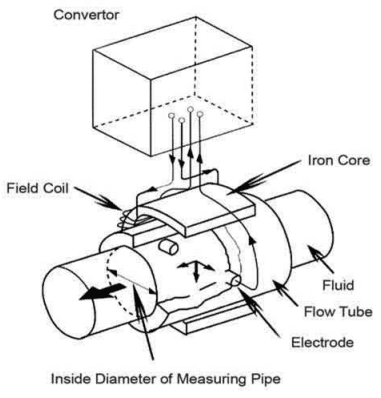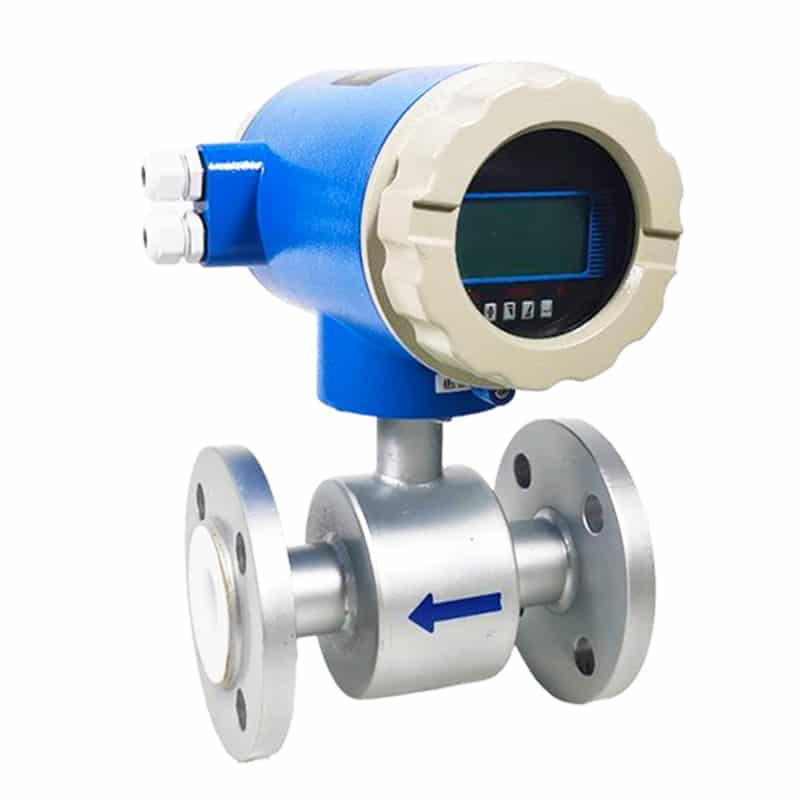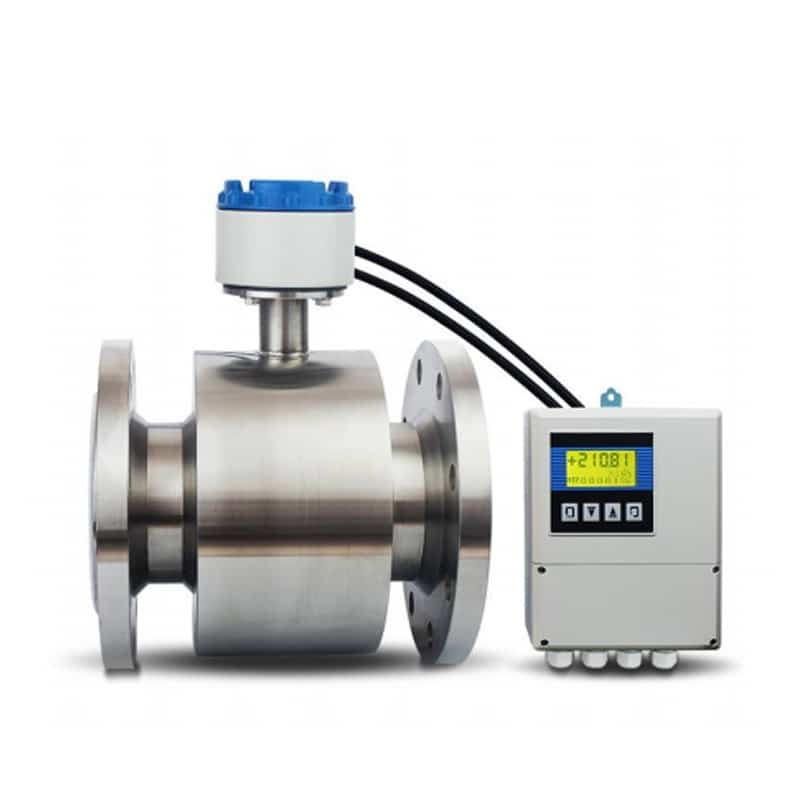In industrial and process control applications, magnetic flow meters are a common device used to measure the flow of liquids. However, in order to ensure the accuracy and reliability of a magnetic flow meter, the conductivity of the liquid plays a crucial role. Conductivity is considered one of the key factors in magnetic flow meters as it directly affects the generation of the induced electromotive force, which in turn affects the strength and stability of the measured signal. For this reason, manufacturers of magnetic flow meters usually specify a minimum conductivity requirement for the liquid.
Magnetic flow meter working principle
A magnetic flow meter is a device commonly used to measure the flow of liquids and utilizes the principle of Faraday’s Law of Electromagnetic Induction. Faraday’s Law of Electromagnetic Induction states that when a conductor (or liquid) moves in a magnetic field, it generates an induced electromotive force around it. Magnetic flow meters utilize this principle to determine flow rate by measuring the magnitude of the induced electromotive force in a liquid.
The magnetic flow meter works as follows:
- Generation of magnetic field: Magnetic flow meters work by generating a stable magnetic field around the pipe. Typically, this is accomplished by installing a pair of magnetic coils on the pipe wall, creating a uniform magnetic field between them.
- Liquid flow: As the liquid passes through the pipe, it becomes a moving conductor. According to Faraday’s Law of Electromagnetic Induction, the motion in the liquid causes an induced electromotive force.
- Measurement of induced electromotive force: Magnetic flow meters measure the magnitude of the induced electromotive force in a liquid by installing a pair of electrodes on the pipe wall. These electrodes are in direct contact with the liquid and are therefore able to detect the induced electromotive force caused by the liquid flow.
- Flow calculation: By measuring the magnitude of the induced electromotive force, the magnetic flow meter can be converted to a flow value based on a pre-calibrated relationship. This calibration relationship is usually established by performing laboratory or field tests on the magnetic flow meter.

The accuracy and reliability of a magnetic flow meter is closely related to the conductivity of the liquid. Liquids with higher electrical conductivity (usually water and many solutions) produce a larger induced electromotive force, which results in more accurate measurements. Conversely, liquids with lower electrical conductivity (such as pure water) may produce a smaller induced electromotive force, which can lead to measurement errors. Therefore, ensuring that the liquid has sufficient electrical conductivity is critical to the accuracy of the magnetic flow meter.
Effect of conductivity on magnetic flow meters
The conductivity of the liquid has an important influence on the performance of the magnetic flow meter, because the measurement principle of the magnetic flow meter is based on the induced electromotive force, and the magnitude of this electromotive force is closely related to the conductivity of the liquid. The following are the effects of liquid conductivity on the performance of magnetic flow meters and the problems that can be caused by low conductivity:
Measurement accuracy: Higher liquid conductivity typically produces a greater induced electromotive force, which improves measurement accuracy. Therefore, the measurement accuracy of a magnetic flow meter may suffer when the conductivity of the liquid is low.
Signal attenuation: Low conductivity liquids generate a smaller induced electromotive force in a magnetic field, which may lead to signal attenuation. This means that the strength of the measurement signal is reduced, which affects the sensitivity and stability of the magnetic flow meter.
Flow rate range limitation: Low conductive liquids may limit the range of flow rates that can be measured by a magnetic flow meter. At lower flow rates, the induced electromotive force may be very weak, preventing the magnetic flow meter from accurately measuring the flow rate.
Flow drift: When the conductivity of the liquid is low, the magnetic flow meter may experience flow drift problems, where the measured value changes over time. This can be caused by changes in the ion concentration or conductivity of the liquid over time.
Significance of the minimum conductivity requirement
Manufacturers of magnetic flow meters often specify minimum conductivity requirements to ensure the accuracy and reliability of the device. These requirements are usually expressed in terms of the minimum conductivity value of the liquid, for example in micro Siemens per centimeter (µS/cm). Below is an explanation of why such minimum requirements are necessary:
- Ensuring the generation of induced electromotive force: The operating principle of a magnetic flow meter is based on the induced electromotive force generated when a liquid moves in a magnetic field. Lower liquid conductivity results in a smaller induced electromotive force being generated, which may affect the accuracy and reliability of the measurement. Therefore, manufacturers specify minimum conductivity requirements to ensure that the liquid has sufficient conductivity to generate a reliable induced electromotive force.
- Improved measurement stability: The conductivity of the liquid directly affects the stability of the measurement signal of the magnetic flow meter. Lower conductivity can lead to fluctuations or drifts in the measurement signal, which in turn affects the stability of the measurement. By specifying minimum conductivity requirements, the possibility of such signal fluctuations can be reduced, thereby improving measurement stability.
- Avoid equipment damage: Magnetic flow meters are usually designed to operate within a specific range, including the conductivity range of the liquid. If the conductivity of a liquid falls below the minimum requirement, the magnetic flow meter may not function properly or may be damaged. Therefore, manufacturers specify minimum conductivity requirements to ensure that the device works within its normal operating range and to avoid damage.
Typical values for minimum conductivity requirements
The range of minimum conductivity values for a typical magnetic flow meter is usually between 3 and 5 microsiemens per centimeter (µS/cm), but the exact values may vary depending on the manufacturer, model and application. Below is an explanation of how these values are determined and why they may vary in different applications:
Determination method: Manufacturers typically determine minimum conductivity requirements based on the design and performance requirements of the magnetic flow meter and the results of laboratory tests. These tests may include laboratory testing of the magnetic flow meter in a variety of conductive fluids to determine the range of conductivities that will provide accurate and reliable measurements.
Accuracy and reliability considerations: Manufacturers take into account the measurement accuracy and reliability of the magnetic flow meter and determine the minimum conductivity requirement based on these factors. Lower conductivity may result in a lower induced electromotive force, which can affect the accuracy and stability of the measurement.
Application requirements: Different applications may have different conductivity requirements for magnetic flow meters. For example, in applications dealing with water and wastewater, where liquids with high conductivity are typically used, the minimum conductivity requirement may be relatively low. In applications handling chemicals or specialty liquids, on the other hand, higher conductivity may be required to ensure accurate measurements.
Environmental factors: Environmental factors may also affect minimum conductivity requirements. For example, in industrial environments, various impurities and contaminants may be present, and these may affect the conductivity of the liquid. Therefore, in this case, a higher minimum conductivity requirement may be needed to ensure accurate and reliable measurements.
Of the minimum conductivity requirements for magnetic flow meters, the difference between 3 and 5 microsiemens per centimeter (µS/cm) may result in differences in measurement range, sensitivity, environmental suitability, and application requirements. Lower requirements may allow measurements in less conductive liquids, while higher requirements may provide better signal strength and greater adaptability to a variety of complex liquid conditions. Therefore, it is critical to select the minimum conductivity requirement that is appropriate for a particular application to ensure that the magnetic flow meter provides accurate and reliable flow measurements.
Apure has three magnetic flow meters, the AYT Digital Liquid Magnetic Flow Meter, the AFT Split Type Electromagnetic Flow Meter and the ACT Insertion Type Magnetic Flowmeter, so you can pick the one that’s right for you.



How to ensure compliance with minimum conductivity requirements
Ensuring that liquids meet minimum conductivity requirements is critical to the accuracy and reliability of magnetic flow meters. The following are methods for ensuring that liquids meet minimum conductivity requirements in different environments and emphasize the importance of regular maintenance and monitoring:
- Liquid selection: the choice of a sufficiently conductive liquid is to ensure the normal operation of the magnetic flow meter key. In the liquid selection, the chemical composition of the liquid should be considered as well as its conductivity characteristics. In some applications, it may be necessary to add appropriate conductive additives to improve the conductivity of the liquid.
- Fluid handling: In some cases, the conductivity of a fluid may be reduced by contaminants, impurities or chemical reactions. Therefore, regular filtration, cleaning and treatment of the fluid is an important step in ensuring that it meets minimum conductivity requirements.
- Environmental controls: In industrial environments, a variety of factors may exist that affect the conductivity of a fluid, such as temperature, humidity and pressure. Therefore, it is important to monitor and control environmental conditions to ensure that the conductivity of the fluid is maintained under appropriate conditions.
- Regular maintenance and calibration: Regular maintenance and calibration of the magnetic flow meter is key to maintaining its consistent performance. This includes cleaning sensors, calibrating instruments and checking the operational status of the equipment. Regular maintenance ensures that the magnetic flow meter operates properly and keeps the liquid conductivity within the proper range.
- Real-time monitoring systems: Installing a real-time monitoring system can help detect abnormal liquid conductivity or other problems in a timely manner. These systems can provide alerts or notifications so that timely action can be taken to make repairs or adjustments.
Overall, proper fluid selection, fluid handling, environmental controls, and regular maintenance and monitoring can ensure that the fluid meets the minimum conductivity requirements of the magnetic flow meter. These measures help to maintain the accuracy and reliability of the magnetic flow meter and ensure accurate flow measurement.
Summary
Minimum conductivity requirements for magnetic flow meters are critical to ensure accurate measurements. Conductivity directly affects the strength and stability of the measurement signal. When selecting and operating a magnetic flow meter, you need to be aware of the conductivity requirements of the fluid and take appropriate measures to maintain the fluid’s conductivity. By following best practices, you can ensure that magnetic flow meters provide reliable flow measurements.
Apure offers magnetic flow meters in addition to vortex flow meters, turbine flow meters, ultrasonic flow meters and float flow meters. Please consult us if you have any questions.
